< Prev Index Next >
 Game of Kings 19 Dec 1960, Mon The Gazette (Montreal, Quebec, Canada) Newspapers.com
Game of Kings 19 Dec 1960, Mon The Gazette (Montreal, Quebec, Canada) Newspapers.com
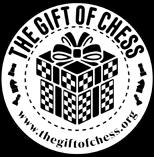
Notice to commercial publishers seeking use of images from this collection of chess-related archive blogs. For use of the many large color restorations, two conditions must be met: 1) It is YOUR responsibility to obtain written permissions for use from the current holders of rights over the original b/w photo. Then, 2) make a tax-deductible donation to The Gift of Chess in honor of Robert J. Fischer-Newspaper Archives. A donation in the amount of $250 USD or greater is requested for images above 2000 pixels and other special request items. For small images, such as for fair use on personal blogs, all credits must remain intact and a donation is still requested but negotiable. Please direct any photographs for restoration and special request (for best results, scanned and submitted at their highest possible resolution), including any additional questions to S. Mooney, at bobbynewspaperblogs•gmail. As highlighted in the ABC News feature, chess has numerous benefits for individuals, including enhancing critical thinking and problem-solving skills, improving concentration and memory, and promoting social interaction and community building. Initiatives like The Gift of Chess have the potential to bring these benefits to a wider audience, particularly in areas where access to educational and recreational resources is limited.
| Best of Chess |
Fischer Newspaper Archives
• Robert J. Fischer, 1955 ➦
• Robert J. Fischer, 1956 ➦ • Robert J. Fischer, 1957 ➦ • Robert J. Fischer, 1958 ➦ • Robert J. Fischer, 1959 ➦ • Robert J. Fischer, 1960 ➦ • Robert J. Fischer, 1961 ➦ • Robert J. Fischer, 1962 ➦ • Robert J. Fischer, 1963 ➦ • Robert J. Fischer, 1964 ➦ • Robert J. Fischer, 1965 ➦ • Robert J. Fischer, 1966 ➦ • Robert J. Fischer, 1967 ➦ • Robert J. Fischer, 1968 ➦ • Robert J. Fischer, 1969 ➦ • Robert J. Fischer, 1970 ➦ • Robert J. Fischer, 1971 ➦ • Robert J. Fischer, 1972 ➦ • Robert J. Fischer, 1973 ➦ • Robert J. Fischer, 1974 ➦ • Robert J. Fischer, 1975 ➦ • Robert J. Fischer, 1976 ➦ • Robert J. Fischer, 1977 ➦ • Robert J. Fischer, 1978 ➦ • Robert J. Fischer, 1979 ➦ • Robert J. Fischer, 1980 ➦ • Robert J. Fischer, 1981 ➦ • Robert J. Fischer, 1982 ➦ • Robert J. Fischer, 1983 ➦ • Robert J. Fischer, 1984 ➦ • Robert J. Fischer, 1985 ➦ • Robert J. Fischer, 1986 ➦ • Robert J. Fischer, 1987 ➦ • Robert J. Fischer, 1988 ➦ • Robert J. Fischer, 1989 ➦ • Robert J. Fischer, 1990 ➦ • Robert J. Fischer, 1991 ➦ • Robert J. Fischer, 1992 ➦ • Robert J. Fischer, 1993 ➦ • Robert J. Fischer, 1994 ➦ • Robert J. Fischer, 1995 ➦ • Robert J. Fischer, 1996 ➦ • Robert J. Fischer, 1997 ➦ • Robert J. Fischer, 1998 ➦ • Robert J. Fischer, 1999 ➦ • Robert J. Fischer, 2000 ➦ • Robert J. Fischer, 2001 ➦ • Robert J. Fischer, 2002 ➦ • Robert J. Fischer, 2003 ➦ • Robert J. Fischer, 2004 ➦ • Robert J. Fischer, 2005 ➦ • Robert J. Fischer, 2006 ➦ • Robert J. Fischer, 2007 ➦ • Robert J. Fischer, 2008 ➦ |
Chess Columns |
< Prev Index Next >
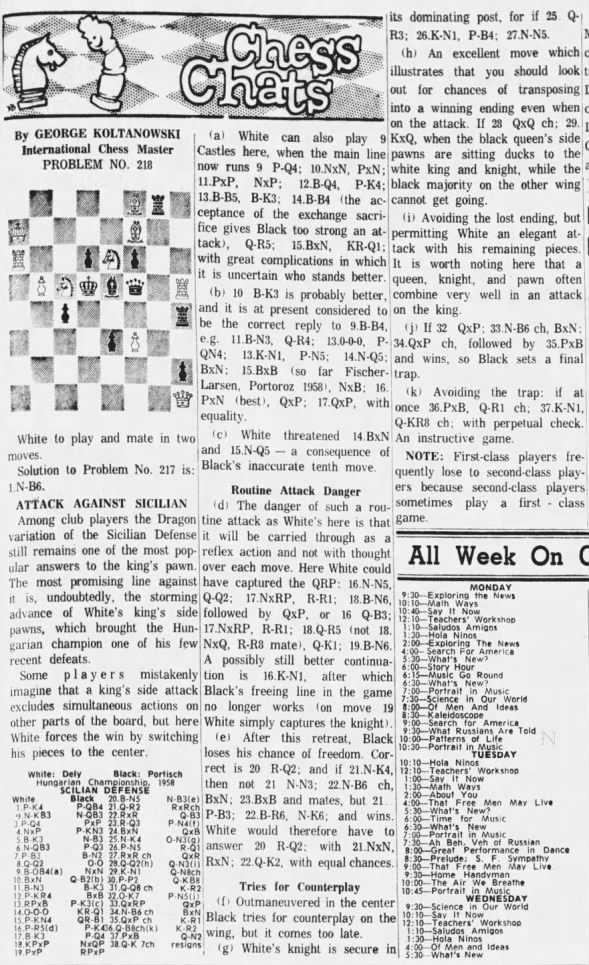 Chess Chats 07 Feb 1960, Sun The Press Democrat (Santa Rosa, California) Newspapers.com
Chess Chats 07 Feb 1960, Sun The Press Democrat (Santa Rosa, California) Newspapers.com
Attack Against Sicilian
Among club players the Dragon variation of the Sicilian Defense still remains one of the most popular answers to the king's pawn. the most promising line against it is, undoubtedly, the storming advance of White's king's side pawns, which brought the Hungarian champion one of his few recent defeats.
Some players mistakenly imagine that a king's side attack excludes simultaneous actions on other parts of the board, but here White forces the win by switching his pieces to the center.
Hungarian Championship, 1958
Peter Dely (white) vs. Lajos Portisch (black)
Sicilian Defense: Dragon Variation, Yugoslav Attack, Main Line
Descriptive 1. P-K4 P-QB4 2. N-KB3 N-QB3 3. P-Q4 PxP 4. NxP P-KN3 5. B-K3 N-B3 6. N-QB3 P-Q3 7. P-B3 B-N2 8. Q-Q2 O-O 9. B-QB4(a) NxN 10. BxN Q-B2(b) 11. B-N3 B-K3 12. P-KR4 BxB 13. RPxB P-K3(c) 14. O-O-O KR-Q 15. P-KN4 QR-B 16. P-R5(d) P-K4 17. B-K3 P-Q4 18. KPxP NxQP 19. PxP RPxP 20. B-N5 N-B3(e) 21. Q-R2 RxRch 22. RxR Q-B3 23. R-Q3 P-N4(f) 24. BxN QxB 25. N-K4 Q-N3(g) 26. P-N5 R-Q 27. RxRch QxR 28. Q-Q2(h) Q-N3(i) 29. K-N Q-N8ch 30. K-R2 Q-KB8 31. Q-Q8ch K-R2 32. Q-K7 P-N5(j) 33. QxRP QxP 34. N-B6ch BxN 35. QxPch K-R 36. Q-B8ch(k) K-R2 37. PxB Q-N2 38. Q-K7ch Resigns |
Algebraic 1. e4 c5 2. Nf3 Nc6 3. d4 cxd4 4. Nxd4 g6 5. Be3 Nf6 6. Nc3 d6 7. f3 Bg7 8. Qd2 0-0 9. Bc4 Nxd4 10. Bxd4 Qc7 11. Bb3 Be6 12. h4 Bxb3 13. axb3 e6 14. 0-0-0 Rd8 15. g4 Rc8 16. h5 e5 17. Be3 d5 18. exd5 Nxd5 19. hxg6 hxg6 20. Bg5 Nf6 21. Qh2 Rxd1+ 22. Rxd1 Qc6 23. Rd3 b5 24. Bxf6 Qxf6 25. Ne4 Qb6 26. g5 Rd8 27. Rxd8+ Qxd8 28. Qd2 Qb6 29. Kb1 Qg1+ 30. Ka2 Qf1 31. Qd8+ Kh7 32. Qe7 b4 33. Qxa7 Qxf3 34. Nf6+ Bxf6 35. Qxf7+ Kh8 36. Qf8+ Kh7 37. gxf6 Qb7 38. Qe7+ 1-0 |
(a) White can also play 9 Castles here, when the main line now runs 9. P-Q4 10. NxN PxN; 11. PxP NxP; 12. B-Q4 P-K4; 13. B-B5 B-K3; 14. B-B4 (the acceptance of the exchange sacrifice gives Black too strong an attack), Q-R5; 15. BxN KR-Q1; with great complications in which it is uncertain who stands better.
(b) 10. B-K3 is probably better, and it is at present considered to be the correct reply to 9. B-B4 e.g., 11. B-N3 Q-R4; 12. O-O-O P-QN4; 13. K-N1 P-N5; 14. N-Q5 BxN; 15. BxB (so far Fischer-Larsen, Portoroz 1958), NxB; 16. PxN (best), QxP; 17. QxP, with equality.
(c) White threatened 14. BxN and 15. N-Q5 — a consequence of Black's inaccurate tenth move.
Routine Attack Danger
(d) The danger of such a routine attack as White's here is that it will be carried through as a reflex action and not with thought over each move. Here White could have captured the QRP; 16. N-N5 Q-Q2; 17. NxRP R-R1; 18. Q-R5 (not 18. NxQ R-R8 mate) Q-K1; 19. B-N6. A possibly still better continuation is 16. K-N1, after which Black's freeing line in the game no longer works (on move 19 White simply captures the knight).
(e) After this retreat, Black loses his chance of freedom. Correct is 20. R-Q2; and if 21. N-K4 then not 21. N-N3 22. N-B6ch, BxN; 23. BxB and mates, but 21. P-B3; 22. B-R6 N-K6 and wins. White would therefore have to answer 20. R-Q2; with 21. NxN RxN; 22. Q-K2, with equal chances.
Tries for Counterplay
(f) Outmaneuvered in the center Black tries for counterplay on the wing, but it comes too late.
(g) White's knight is secure in its dominating post, for if 24. Q-R3; 26. K-N1, P-B4; 27. N-N5.
(h) An excellent move which illustrates that you should look out for chances of transposing into a winning ending even when on the attack. If 28. QxQch; 29. KxQ, when the black queen's side pawns are sitting ducks to the white king and knight, while the black majority on the other wing cannot get going.
(i) Avoiding the lost ending, but permitting White an elegant attack with his remaining pieces. It is worth noting here that a queen, knight, and pawn often combine very well in an attack on the king.
(j) If 32. QxP; 33. N-B6ch BxN; 34. QxP ch, followed by 35. PxB and wins, so Black sets a final trap.
(k) Avoiding the trap: if at once 36. PxB Q-R1 ch; 37. K-N1, Q-KR8 ch; with perpetual check. An instructive game.
NOTE: First-class players frequently lose to second-class players because second-class players sometimes play a first-class game.
< Prev Index Next >
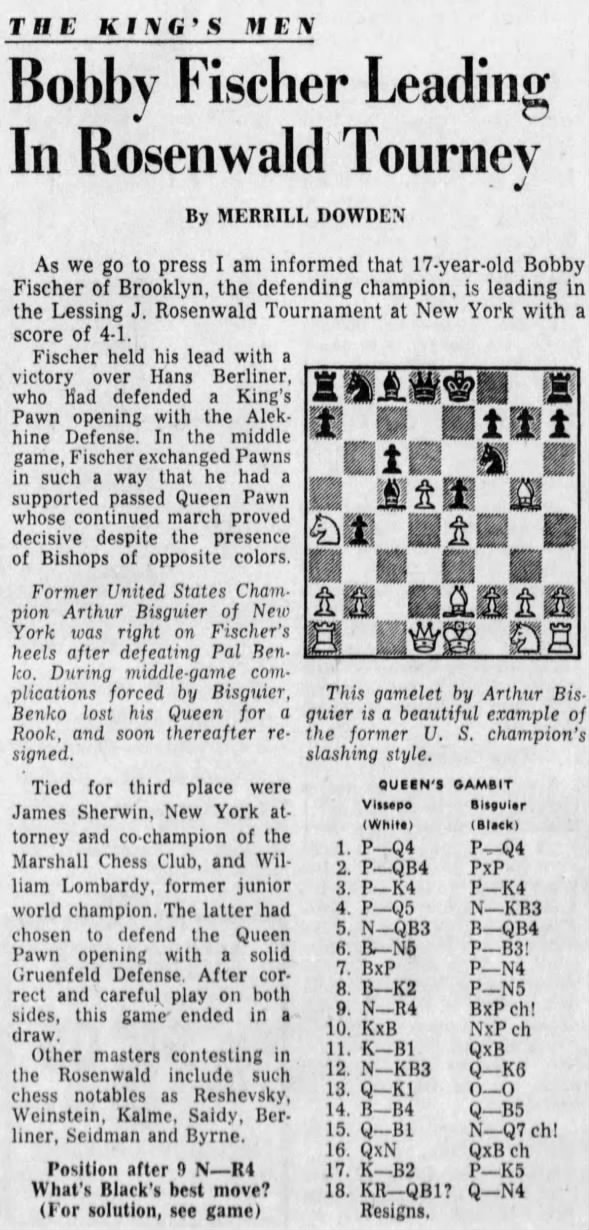 The King's Men 25 Dec 1960, Sun The Courier-Journal (Louisville, Kentucky) Newspapers.com
The King's Men 25 Dec 1960, Sun The Courier-Journal (Louisville, Kentucky) Newspapers.com
Bobby Fischer Leading In Rosenwald Tourney
By Merrill Dowden
As we go to press I am informed that 17-year-old Bobby Fischer of Brooklyn, the defending champion, is leading in the Lessing J. Rosenwald Tournament at New York with a score of 4-1.
Fischer held his lead with a victory over Hans Berliner, who had defended a King's Pawn opening with the Alekhine Defense. In the middle game, Fischer exchanged Pawns in such a way that he had a supported passed Queen Pawn whose continued march proved decisive despite the presence of Bishops of opposite colors.
< Prev Index Next >
 Chess By Isaac Kashdan 20 Nov 1960, Sun The Los Angeles Times (Los Angeles, California) Newspapers.com
Chess By Isaac Kashdan 20 Nov 1960, Sun The Los Angeles Times (Los Angeles, California) Newspapers.com
Chess Olympics Results
Following are the final standings of the 40 teams in the 14th Chess Olympics at Leipzig, for the benefit of those who missed the daily reports, which appeared regularly in the news pages of The Times:
CHAMPIONSHIP CLASS— U.S.S.R., 34; U.S.A., 29; Yugoslavia, 27; Hungary, 22½; Czechoslovakia, 21½; Bulgaria, 21; Argentina, 20½; West Germany, 19½; East Germany, 19; Holland, 17; England, 16½; Rumania, 16½.
CLASS B—Sweden, 27½; Israel, 26½; Austria, 24½; Denmark, 23½; Finland, 23½; Cuba, 23; Norway, 23; Spain, 22½; Poland, 22; Chile, 19½ Iceland, 16½; India, 12.
CLASS C—Philippines, 28½ Indonesia, 27½ Mongolia, 27½; Albania, 26½; Ecuador, 26; France, 25; Portugal, 25; Italy, 24; Belgium, 32½; Tunisia, 21½; Greece, 20½; Bolivia, 19½; Monaco, 17½; Malta, 14; Lebanon, 8½.
Each team played nine rounds in a preliminary round-robin and 11 rounds in the finals. The following table shows the performance of the American and Russian squads, giving the individual results in the preliminaries and finals, the total score and the percentage.
The Russians used every player about the same number of times, taking advantage of their almost uniform strength. We did not use the two reserves nearly as frequently as the regulars.
U.S. champion Bobby Fischer, who played every game in the finals did substantially as well as world champion Mikhail Tal. Robert Byrne made the best percentage for the Americans, almost equaling Paul Keres on the third board.
< Prev Index Next >
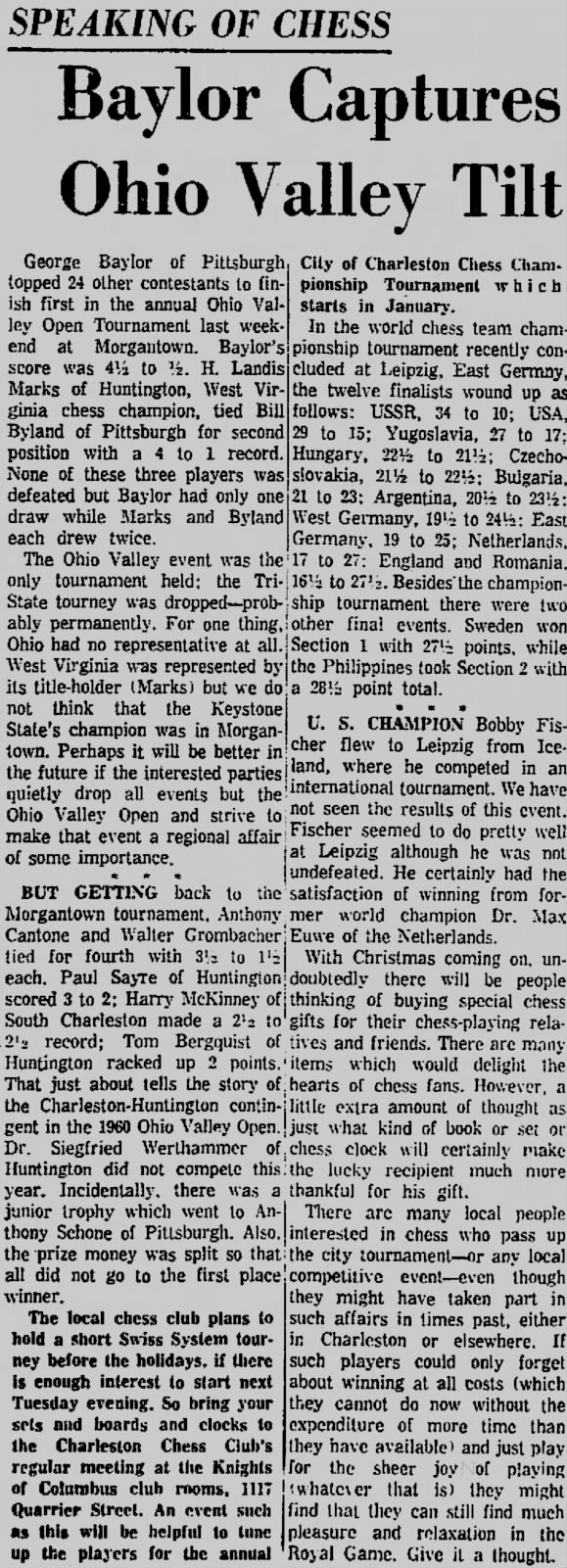 Speaking of Chess 20 Nov 1960, Sun Sunday Gazette-Mail (Charleston, West Virginia) Newspapers.com
Speaking of Chess 20 Nov 1960, Sun Sunday Gazette-Mail (Charleston, West Virginia) Newspapers.com
“In the world chess team championship tournament recently concluded at Leipzig, East Germany, the twelve finalists wound up as follows: USSR, 34 to 10, USA, 29 to 15; Yugoslavia, 27 to 17; Hungary, 22½ to 21½; Czechoslovakia, 21½ to 22½; Bulgaria 21 to 23; Argentina, 20½ to 23½; West Germany, 19½ to 24½; East Germany 19 to 25; Netherlands, 17 to 27; England and Romania, 16½ to 27½. Besides the championship tournament there were two other final events. Sweden won Section 1 with 27½ points, while the Philippines took Section 2 with a 28½ point total.
U.S. Champion Bobby Fischer flew to Leipzig from Iceland, where he competed in an international tournament. We have not seen the results of this event. Fischer seemed to do pretty well at Leipzig although he was not undefeated. He certainly had the satisfaction of winning from former world champion Dr. Max Euwe of the Netherlands.”
< Prev Index Next >
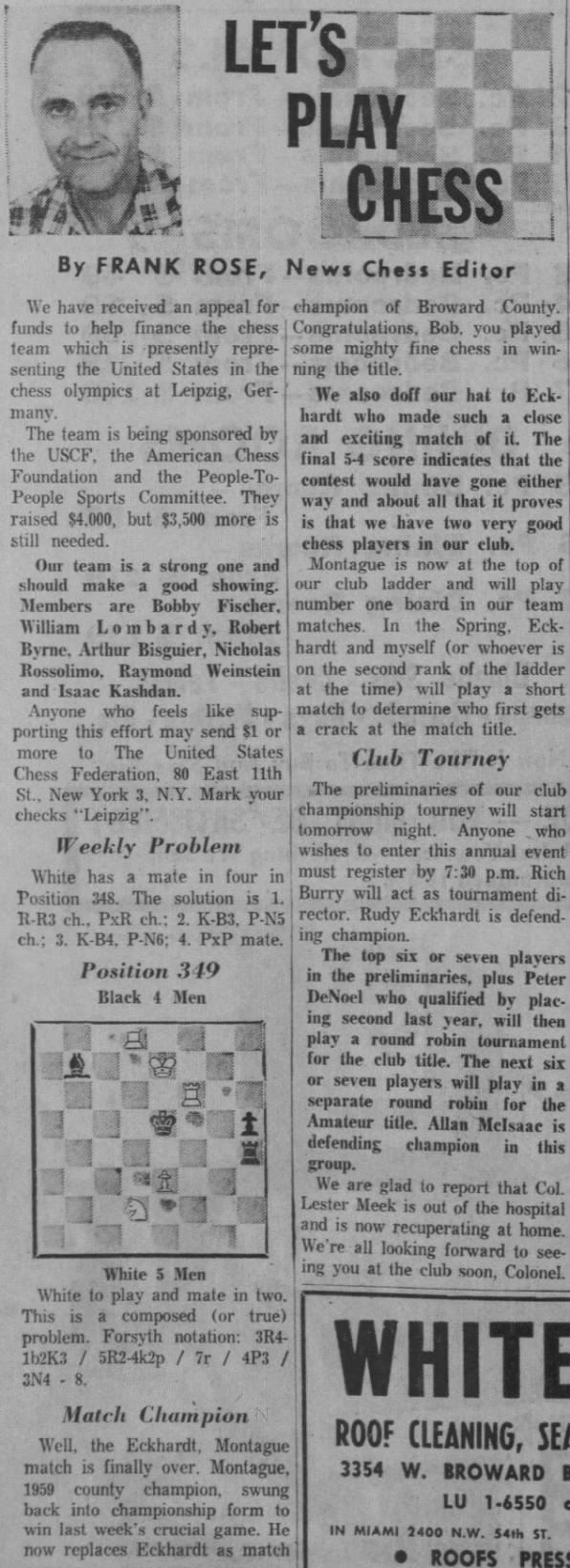 Let's Play Chess 13 Nov 1960, Sun Fort Lauderdale News (Fort Lauderdale, Florida) Newspapers.com
Let's Play Chess 13 Nov 1960, Sun Fort Lauderdale News (Fort Lauderdale, Florida) Newspapers.com
We have received an appeal for funds to help finance the chess team which is presently representing the United States in the chess olympics at Leipzig, Germany.
The team is being sponsored by the USCF, the American Chess Foundation and the People-To-People Sports Committee. They raised $4,000, but $3,500 more is still needed.
Our team is a strong one and should make a good showing. Members are Bobby Fischer, William Lombardy, Robert Byrne, Arthur Bisguier, Nicolas Rossolimo, Raymond Weinstein and Isaac Kashdan.
Anyone who feels like supporting this effort may send $1 or more to the United States Chess Federation, 80 East 11th St., New York, N.Y. Mark your check, “Leipzig”.
< Prev Index Next >
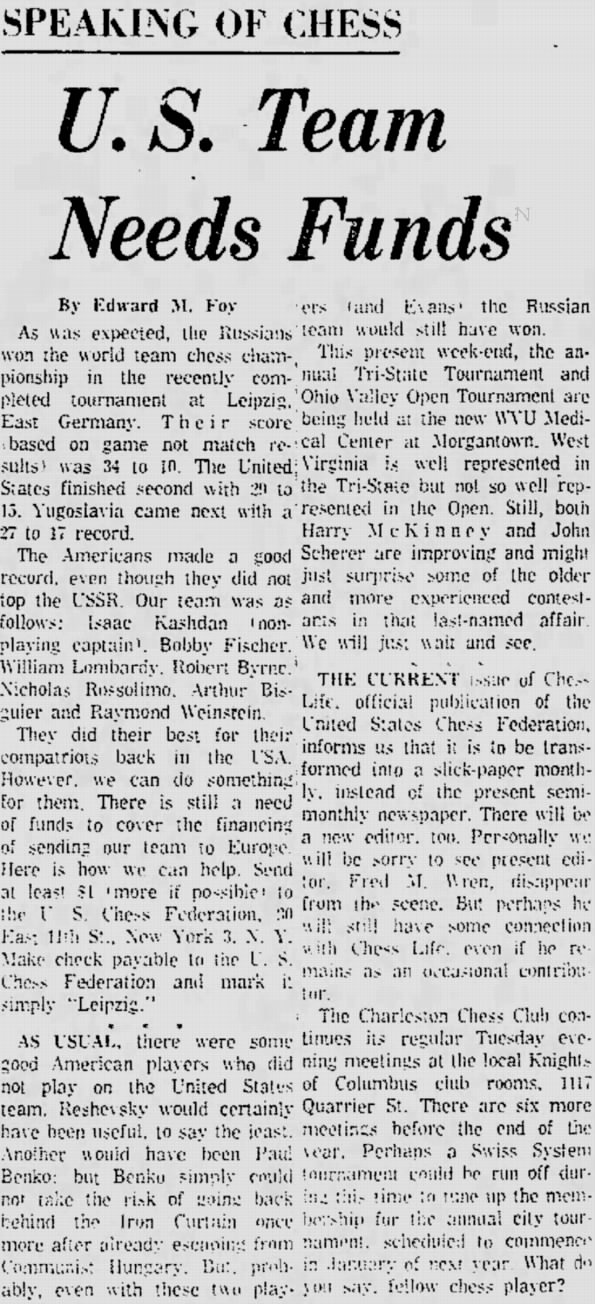 U.S. Team Needs Funds 13 Nov 1960, Sun Sunday Gazette-Mail (Charleston, West Virginia) Newspapers.com
U.S. Team Needs Funds 13 Nov 1960, Sun Sunday Gazette-Mail (Charleston, West Virginia) Newspapers.com
U.S. Team Needs Funds
By Edward M. Foy
As was expected, the Russians won the world team chess championship in the recently completed tournament at Leipzig, East Germany. Their score based on game not match results was 34 to (illegible 10?). The United States finished second with 29 to 15. Yugoslavia came next with a 27 to 17 record.
The Americans made a good record, even though they did not top the USSR. Our team was as follows: Isaac Kashdan (non-playing captain). Bobby Fischer, William Lombardy, Robert Byrne, Nicholas Rossolimo, Arthur Bisguier and Raymond Weinstein.
They did their best for their compatriots back in the USA. However, we can do something for them. There is still a need of funds to cover the financing of sending out team to Europe. Here is how we can help. Send at least $1 (more if possible to the U.S. Chess Federation, on East 11th St. New York, 3 NY Make check payable to the U.S. Chess Federation and mark it simply “Leipzig”
AS USUAL, there were some good American players who did not play on the United States team. Reshevsky would certainly have been useful to say the least. Another would have been Paul Benko: but Benko simply could not take the risk of going back behind the Iron Curtain once more after already escaping from Communist Hungary. But probably, even with these two players (and Evans) the Russian team would still have won.
< Prev Index Next >
 Chess by Isaac Kashdan 06 Nov 1960, Sun The Los Angeles Times (Los Angeles, California) Newspapers.com
Chess by Isaac Kashdan 06 Nov 1960, Sun The Los Angeles Times (Los Angeles, California) Newspapers.com
Leipzig Good Site For Chess Olympics
Arranging and conducting a tournament such as the Chess Olympics is a massive operation, requiring considerable advance preparation and plenty of money and manpower.
The East German and Leipzig officials went into action late in 1958, after the completion of the 13th Chess Olympics in Munich, West Germany. Based on discussions with players who were at Munich, they have clearly succeeded.
Excellent arrangements were made for comfort and convenience, both at the playing site and at the hotels. The players are quartered in the two leading hotels in Leipzig, the Astoria and the Park.
On arrival each player was given tickets for a value of 22 marks per day, sufficient for three good meals and an accompanying beer or two. He was also given 50 marks each 10 days for spending money, and a card entitling him to free transportation within the city. Considering that some 250 participants are involved, the cash outlay runs high.
The tournament is being held in a three-story building generally used for large receptions and exhibitions. There are 40 chess games in a large central area on each of two floors. The building is exceptionally well lighted, a prime requisite that is not always available in chess events.
Seats for spectators are spaced near each team, but in no way interfering with the players. For those who cannot get too near the games, the moves are reproduced on large wall boards. An official is assigned to each match to make sure that proper decorum is observed.
On coming to his board, each player is provided with a thermos of coffee or tea and a piece of pastry. More is available on request. Each team has its own cloak room, where pre-game conferences can be held and captains and reserve players can wait for developments.
A special press center is set up for the journalists, with wireless and long distance phone facilities available at all times. Typewriters and mimeograph machines are busy grinding out results. Bulletins containing the moves of all games played are available within 24 hours. All kinds of statistics are compiled and posted regularly.
Reporters are always around, looking for sidelights and interviewing players and officials. The tournament is regularly featured on local radio news programs. Comments by master players on feature games are also broadcast daily.
An unusually interesting feature at the tournament site is an exhibition of Chess Through the Ages. This is a series of displays in glass cases along the walls on both playing floors.
Many unusual and fascinating chess sets have been collected for the exhibition, as well as old books and manuscripts on the game. Many of the participating nations were given space for their own displays of pictures and unusual chess material, ancient and modern.
Even the sophisticated chess masters frequently take time out for another look at the many displays. These may vary from an Arabic chess problem composed in 1100 to a chess set based on electronic devices.
Games From Olympics
The following games were played in the preliminary rounds of the Chess Olympics.
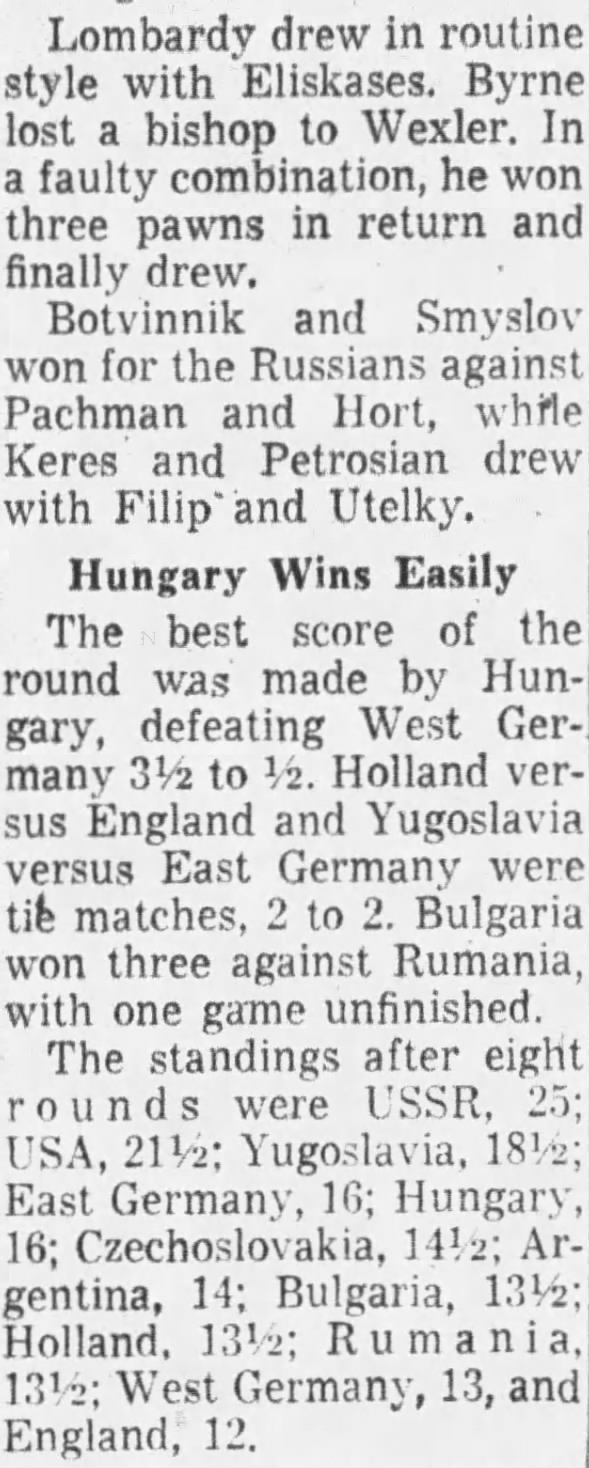
 U.S. Defeats Argentina in Chess Match 06 Nov 1960, Sun The Los Angeles Times (Los Angeles, California) Newspapers.com
U.S. Defeats Argentina in Chess Match 06 Nov 1960, Sun The Los Angeles Times (Los Angeles, California) Newspapers.com
U.S. Defeats Argentina in Chess Match
By Isaac Kashdan, Times Chess Editor
Leipzig—The American team has defeated Argentina by 2½ to 1½ in the Chess Olympics here, consolidating its second place position.
The Russians, who are defending champions, improved their hold on first place by a 3-1 victory over Czechoslovakia.
The only winner for the Americans was Bisguier on the fourth board, who outplayed Foguelman to win two pawns and the game.
Fischer Loses Advantage
Bobby Fischer gained considerable advantage in the first session against Najdorf, but misplayed after the adjournment, allowing a draw ending.
Lombardy drew in routine style with Eliskases. Byrne lost a bishop to Wexler. In a faulty combination, he won three pawns in return and finally drew.
Botvinnik and Smyslov won for the Russians against Pachman and Hort, while Keres and Petrosian drew with Filip and Utelky.
Hungary Wins Easily
The best score of the round was made by Hungary, defeating West Germany 3½ to ½. Holland versus England and Yugoslavia versus East Germany were tie matches, 2 to 2. Bulgaria won three against Rumania, with one game unfinished.
The standings after eight rounds were USSR, 25; USA, 21½; Yugoslavia, 18½; East Germany, 16; Hungary, 16; Czechoslovakia, 14½; Argentina, 14; Bulgaria, 13½; Holland, 13½; Rumania, 13½; West Germany, 13, and England, 12.
< Prev Index Next >
 Chess With Sam Laird 02 Nov 1960, Wed Courier-Post (Camden, New Jersey) Newspapers.com
Chess With Sam Laird 02 Nov 1960, Wed Courier-Post (Camden, New Jersey) Newspapers.com
U.S. Russian Teams In Olympics Finals
As expected, the United States and the Soviet Union teams have reached the finals of the chess Olympics at Leipzig.
The American team of Fischer, Lombardy, Byrne, Bisguier, Weinstein and Rossolimo finished with a score of 29-7 to capture first place in Section 4 of the preliminary round. Russia's team had an even better score of 32-4 in Section 2.
Bulgaria triumphed in Section 1, with England and Czechoslovakia tying for the lead in Section 3. These five teams, plus seven others—three from each section—will compete in the round-robin finals.
Each of the Americans helped creditably in reaching the finals. Bobby Fischer was involved in one of the big upsets in the matches when he lost his second-round game to Munoz of Ecuador. Subsequently he made up for this disappointment and finished in the final round with a brilliant queen sacrifice that gave him a 55-move victory over Wolfgang Unzicker of West Germany. Unzicker had gone through the tournament undefeated to that point.
The country is probably lucky that we were able to send a team to Leipzig at all. Our State Department was not enthusiastic about our competing, since Leipzig is in Russian-dominated East Germany.
The cost of sending our six players, plus non-playing captain Irving Kashdan, is about $6,000. Not until the very last minute were the American Chess Foundation, U.S. Chess Federation, and People-to-People Sports Committee able to get together and decide to send the team, hoping that American chess enthusiasts will contribute enough to repay them. In view of American chess fans' reaction to similar appeals in the past, the sponsors are obviously congenital optimists.
The 24-game return match for the world's championship between champion Mikhail Tal and the man he dethroned this year, Mikhail Botvinnik, now has been scheduled to begin in Moscow in February. It will consist of 24 games unless one contestant wins 12½ points earlier. Tal, who was injured in an auto accident going to the Leipzig Olympics, recovered quickly and played for the Soviet team there.
< Prev Index Next >
 The King's Men 30 Oct 1960, Sun The Courier-Journal (Louisville, Kentucky) Newspapers.com
The King's Men 30 Oct 1960, Sun The Courier-Journal (Louisville, Kentucky) Newspapers.com
Chess Review Editor I.A. Horowitz was facing 10 opponents simultaneously when he won this game from Hans Berliner, who himself is of master rank.
I.A. Horowitz (white) vs. Hans Berliner (black)
Queen's Gambit Accepted: Classical Defense, Alekhine System
Descriptive 1. P-Q4 P-Q4 2. P-QB4 PxP 3. N-KB3 N-KB3 4. P-K3 P-B4 5. BxP P-K3 6. O-O P-QR3 7. Q-K2 QN-Q2 8. R-Q1 Q-B2 9. B-Q3 P-QN4 10. QN-Q2 B-N2 11. P-QR4 P-B5 12. B-B2 N-Q4 13. P-K4 N-N5 14. B-N1 B-K2 15. N-B1 O-O 16. N- 3 P-N3 17. Q-K3 P-K4 18. Q-R6 KR-Q1 19. N-N5 N-KB3 20. P-Q5 P-B6 21. PxP QxP 22. R-R3 B-Q5 23. N-R5! PxN 24. R-KN3 Resigns |
Algebraic 1. d4 d5 2. c4 dxc4 3. Nf3 Nf6 4. e3 c5 5. Bxc4 e6 6. 0-0 a6 7. Qe2 Nd7 8. Rd1 Qc7 9. Bd3 b5 10. Nd2 Bb7 11. a4 c4 12. Bc2 Nd5 13. e4 Nb4 14. Bb1 Be7 15. Nf1 0-0 16. Ng3 g6 17. Qe3 e5 18. Qh6 Rd8 19. Ng5 Nf6 20. d5 c3 21. bxc3 Qxc3 22. Ra3 Bd6 23. Nh5! gxh5 24. Rb3 1-0 |
< Prev Index Next >
 The Game of Kings 22 Oct 1960, Sat The Gazette (Montreal, Quebec, Canada) Newspapers.com
The Game of Kings 22 Oct 1960, Sat The Gazette (Montreal, Quebec, Canada) Newspapers.com
Borge Andersen vs Tigran V Petrosian
Nimzowitsch Memorial (1960), Copenhagen DEN, Aug-??
King's Indian Defense: Saemisch. Closed Variation 7…c6 (E88) 0-1
Mikhail Tal vs Klaus Darga
FRG-URS (1960), Hamburg FRG, rd 7, Aug-04
Sicilian Defense: Scheveningen. Fianchetto Variation (B80) 1-0
< Prev Index Next >
 The Game of Kings 29 Oct 1960, Sat The Gazette (Montreal, Quebec, Canada) Newspapers.com
The Game of Kings 29 Oct 1960, Sat The Gazette (Montreal, Quebec, Canada) Newspapers.com
Chess Olympics
A record entry of forty-one countries are represented in the world team championship at Leipzig. The U.S.A. team has been strengthened by the addition of W. Lombardy, who was recently accorded grandmaster status by the FIDE. Although both he and Bobby Fischer dropped games in the early rounds of the preliminaries the team is well on the way to qualifying for the championship final.
World Champion Injured
Mikhail Tal suffered a slight brain concussion in an auto accident on his way to the world team championship. After a few days rest doctors allowed him to continue but advised against playing. However, he turned up for the fourth round and brilliantly defeated Campomanes of the Philippines in 27 moves to give the USSR a 3-1 victory.
From a team match, Germany, 1956:
Dahl (white) vs. W. Schulz (black)
Ruy Lopez: Open, Classical Defense
Descriptive 1. P-K4 P-K4 2. N-KB3 N-QB3 3. B-N5 P-QR3 4. B-R4 N-B3 5. O-O P-QN4 6. B-N3 NxP 7. P-Q4 P-Q4 8. PxP B-K3 9. P-B3 B-K2 10. B-K3 O-O 11. QN-Q2 B-KN5 12. NxN PxN 13. Q-Q5! PxN 14. QxN PxP 15. QxKNP Q-Q2 16. Q-N3! P-B3 17. P-K6! BxP 18. B-Q4! P-B3 19. Q-N4! K-B2 20. KR-K1 Resigns |
Algebraic 1. e4 e5 2. Nf3 Nc6 3. Bb5 a6 4. Ba4 Nf6 5. 0-0 b5 6. Bb3 Nxe4 7. d4 d5 8. dxe5 Be6 9. c3 Be7 10. Be3 0-0 11. Nd2 Bg4 12. Nxe4 dxe4 13. Qd5! exf3 14. Qxc6 fxg2 15. Qxg2 Qd7 16. Qg3! c6 17. e6! Bxe6 18. Bd4! f6 19. Qg4! Kf7 20. Re1 1-0 |
Paul Troeger vs Mikhail Tal
FRG-URS (1960), Hamburg FRG, rd 6, Aug-02
Dutch Defense: Staunton Gambit. General Variation (A83) 0-1
< Prev Index Next >
 Chess 20 Oct 1960, Thu The Guardian (London, Greater London, England) Newspapers.com
Chess 20 Oct 1960, Thu The Guardian (London, Greater London, England) Newspapers.com
England v. Holland
England's narrow defeat by a Dutch team lacking Euwe was disappointing; but our preponderance of improving young players makes it likely that we shall not have to wait long before we begin a run of wins against Holland.
On the whole the Dutch had the lucky breaks: in his normal form, Milner-Barry would have scored 1½ points instead of none from his middle game positions, while Penrose, Alexander, and Mardle all missed clear chances.
Littlewood's two brilliancies were the highlight of the match. Orbaan's timid defence made him a natural victim, but Littlewood's combinative talent is so marked that one would like to see him in a master tournament. It is to be hoped that there will be a vacancy for him or Mardle (who was also a success at Flushing) in the next Hastings Premier.
John E. Littlewood (white) vs. Constant Orban (black)
Sicilian Defense: French Variation, Normal
Descriptive 1. P-K4 P-QB4 2. N-KB3 P-K3 3. P-Q4 PxP 4. NxP N-KB3 5. B-Q3 N-B3 6. B-K3 P-Q4 7. N-Q2 B-K2 8. O-O Q-B2 9. N-N5 Q-N 10. P-KB4 PxP 11. NxKP P-QR3 12. N(N5)-B3 O-O 13. Q-B3 Q-B2 14. Q-R3 NxN 15. NxN P-B4 16. N-N5 BxN 17. PxB N-K2 18. P-KN4 N-N3 19. QR-K B-Q2 20. PxP PxP 21. B-Q4 P-B5 22. R-K7 NxR 23. QxPch K-B2 24. QxPch K-K 25. B-N6ch NxB 26. QxNch K-Q 27. B-N6 P-B6 28. Q-Q6 QxBch 29. QxQch K-K2 30. Q-N4ch K-K 31. R-Kch K-B2 32. R-K7ch Resigns |
Algebraic 1. e4 c5 2. Nf3 e6 3. d4 cxd4 4. Nxd4 Nf6 5. Bd3 Nc6 6. Be3 d5 7. Nd2 Be7 8. 0-0 Qc7 9. Nb5 Qb8 10. f4 dxe4 11. Nxe4 a6 12. Nbc3 0-0 13. Qf3 Qc7 14. Qh3 Nxe4 15. Nxe4 f5 16. Ng5 Bxg5 17. fxg5 Ne7 18. g4 Ng6 19. Rfe1 Bd7 20. gxf5 exf5 21. Bd4 f4 22. Re7 Nxe7 23. Qxh7+ Kf7 24. Qxg7+ Ke8 25. Bg6+ Nxg6 26. Qxg6+ Kd8 27. Bb6 f3 28. Qd6 Qxb6+ 29. Qxb6+ Ke7 30. Qb4+ Ke8 31. Re1+ Kf7 32. Re7+ 1-0 |
< Prev Index Next >
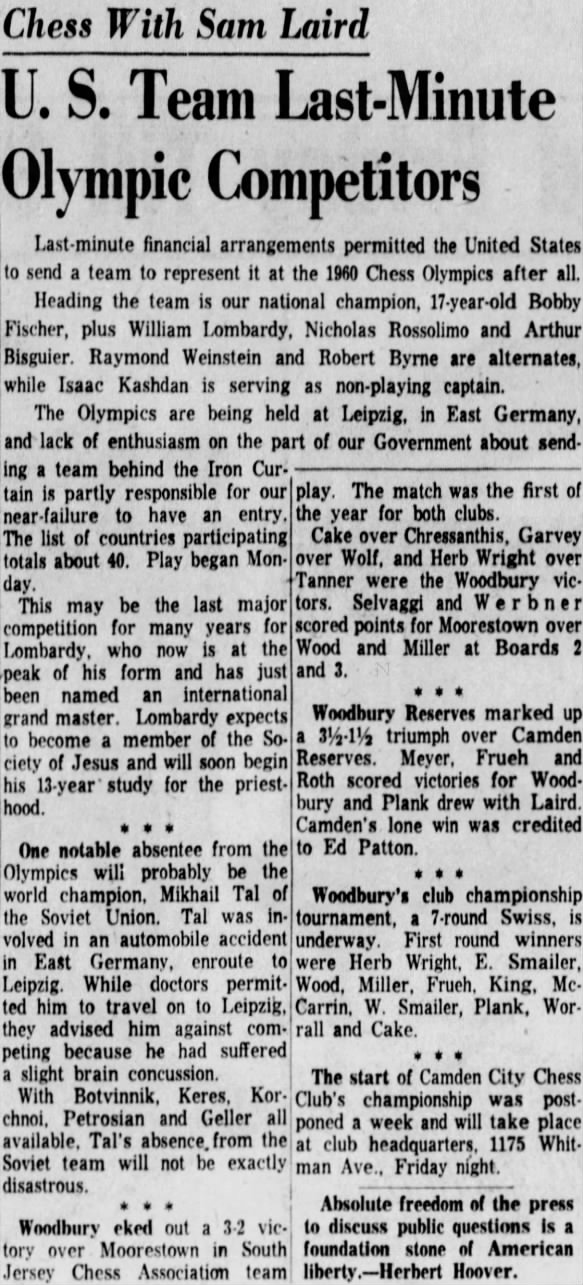 U.S. Team Last-Minute Olympic Competitors 19 Oct 1960, Wed Courier-Post (Camden, New Jersey) Newspapers.com
U.S. Team Last-Minute Olympic Competitors 19 Oct 1960, Wed Courier-Post (Camden, New Jersey) Newspapers.com
U.S. Team Last-Minute Olympic Competitors
Last-minute financial arrangements permitted the United States to send a team to represent it at the 1960 Chess Olympics after all.
Heading the team is our national champion, 17-year-old Bobby Fischer, plus William Lombardy, Nicholas Rossolimo and Arthur Bisguier. Raymond Weinstein and Robert Byrne are alternates, while Isaac Kashdan is serving as non-playing captain.
The Olympics are being help at Leipzig, in East Germany, and lack of enthusiasm on the part of our Government about sending a team behind the Iron Curtain is partly responsible for our near-failure to have an entry. The list of countries participating totals about 40. Play began Monday.
This may be the last major competition for many years for Lombardy, who now is at the peak of his form and has just been named an international grand master. Lombardy expects to become a member of the Society of Jesus and will soon begin his 13-year study for the priesthood.
One notable absentee from the Olympics will probably be the world champion, Mikhail Tal of the Soviet Union. Tal was involved in an automobile accident in East Germany, en route to Leipzig. While doctors permitted him to travel on to Leipzig, they advised him against competing because he had suffered a slight brain concussion.
With Botvinnik, Keres, Korchnoi, Petrosian and Geller all available, Tal's absence from the Soviet team will not be exactly disastrous.
< Prev Index Next >
 Chess By Isaac Kashdan 23 Oct 1960, Sun The Los Angeles Times (Los Angeles, California) Newspapers.com
Chess By Isaac Kashdan 23 Oct 1960, Sun The Los Angeles Times (Los Angeles, California) Newspapers.com
Shipman Tops New York
A tournament for the championship of Greater New York, conducted by the U.S. Chess Federation, attracted a field of 126 in a six-round Swiss system event. The winner, after breaking a three-way tie at 5½-½, was Walter J. Shipman of New York. August Rankis was placed second, and Brian Owens took the third trophy.
Following is an example of the winner's skill:
Cohen (white) vs. Walter J. Shipman (black)
Queen's Gambit Declined: Modern Variation
Descriptive 1. P-QB4 N-KB3 2. N-QB3 P-K3 3. P-Q4 P-Q4 4. B-N5 P-B3 5. N-B3 QN-Q2 6. PxP BPxP 7. P-K3 B-Q3 8. B-Q3 P-QR3 9. O-O P-R3 10. B-R4 O-O 11. R-B P-QN4 12. P-R4 P-N5 13. N-K2 B-N2 14. B-N3 BxB 15. NxB P-QR4 16. Q-K2 Q-N3 17. R-B2 QR-B 18. KR-B RxR 19. RxR P-N6 20. R-B3 B-B3 21. B-N5 BxB 22. PxB P-R5 23. R-B6 Q-R4 24. R-R6 Q-N5 25. N-K5 NxN 26. PxN N-Q2 27. P-B4 N-B4 28. R-R7 Q-B5 29. P-R3 P-N3 30. Q-N4 Q-QB8ch 31. K-R2 P-R6 32. RxRP QxNP 33. R-R7 Q-B8 34. N-R5 N-K5 35. R-R6 P-N7 36. RxP Q-R8ch! 37. KxQ N-B7ch Resigns |
Algebraic 1. c4 Nf6 2. Nc3 e6 3. d4 d5 4. Bg5 c6 5. Nf3 Nd7 6. cxd5 cxd5 7. e3 Bd6 8. Bd3 a6 9. 0-0 h6 10. Bh4 0-0 11. Rc1 b5 12. a4 b4 13. Ne2 Bb7 14. Bg3 Bxg3 15. Nxg3 a5 16. Qe2 Qb6 17. Rc2 Rc8 18. Rc1 Rxc2 19. Rxc2 b3 20. Rc3 Bc6 21. Bb5 Bxb5 22. axb5 a4 23. Rc6 Qa5 24. Ra6 Qb4 25. Ne5 Nxe5 26. dxe5 Nd7 27. f4 Nc5 28. Ra7 Qc4 29. h3 g6 30. Qg4 Qc1+ 31. Kh2 a3 32. Rxa3 Qxb2 33. Ra7 Qc1 34. Nh5 Ne4 35. Ra6 b2 36. Rxe6 Qh1+! 37. Kxh1 Nf2+ 0-1 |
Lajos Portisch vs Gedeon Barcza
Budapest (1960)
Queen's Gambit Declined: Neo-Orthodox Variation. Main Line (D55) 0-1
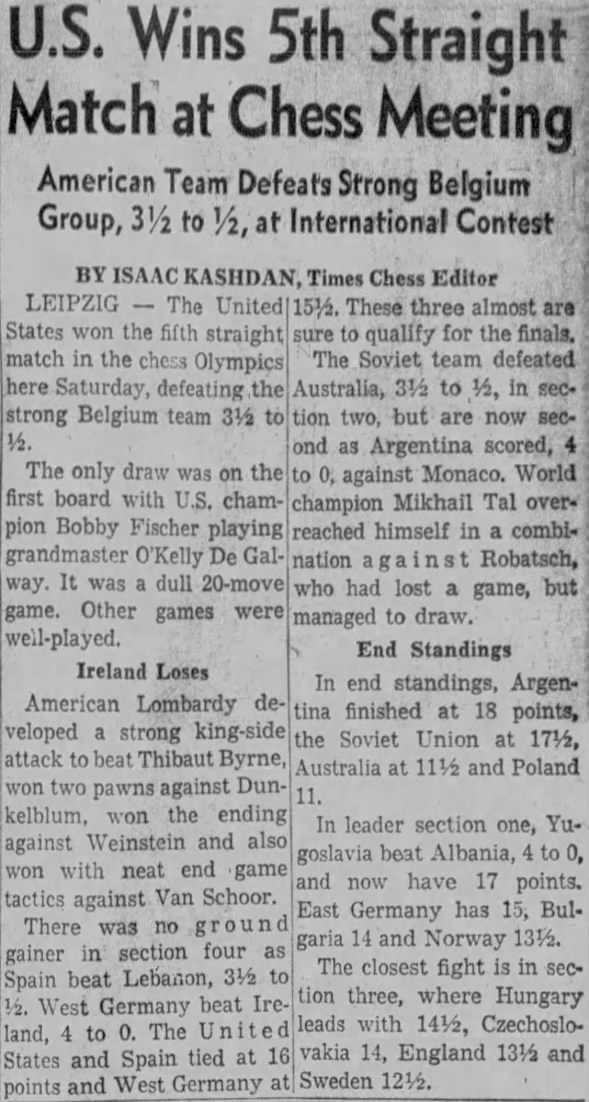 U.S. Wins 5th Straight Match at Chess Meeting 23 Oct 1960, Sun The Los Angeles Times (Los Angeles, California) Newspapers.com
U.S. Wins 5th Straight Match at Chess Meeting 23 Oct 1960, Sun The Los Angeles Times (Los Angeles, California) Newspapers.com
< Prev Index Next >
 Chess By Isaac Kashdan 09 Oct 1960, Sun The Los Angeles Times (Los Angeles, California) Newspapers.com
Chess By Isaac Kashdan 09 Oct 1960, Sun The Los Angeles Times (Los Angeles, California) Newspapers.com
Russians Favored In Leipzig Tourney
The Soviet Union is sending a team of six grandmasters to the Chess Olympics in Leipzig which is probably the strongest aggregation ever to represent one country in a single event.
Leading the line-up will be recently crowned world championship Mikhail Tal, and the man he succeeded, Mikhail Botvinnik. Others, according to a report in the New York Times, are Paul Keres, Victor Korchnoi, Tigran Petrosian and Ewkim Geller.
The entry of the United States, announced last week, makes a roster of 37 nations ready for the opening bell on Oct. 16. Several others may still be heard from. Following is the list:
Albania, Austria, Argentina, Belgium, Bolivia, Bulgaria, Chile, China, Cuba, Czechoslovakia, Denmark, Ecuador, England, East Germany, Finland, France, Greece, the Netherlands, Hungary, Iceland, India, Israel, Italy Lebanon, Monaco, Mongolia, Norway, the Philippines, Puerto Rico, Rumania, the Soviet Union, Sweden, Spain, Tunisia, the U.S.A., West Germany and Yugoslavia.
Our team finished in fourth place in the previous team championship tournament at Munich two years ago and should do at least as well this time. The Russians, who won by a wide margin, are heavily favored to repeat.
Your editor is leaving for New York Tuesday morning to join his teammates for the flight to Germany. Robert Byrne is coming from Indianapolis. The others on the U.S. team, all New Yorkers, are Bobby Fischer, Arthur Bisguier, Nicholas Rossolimo and Raymond Weinstein.
Because of the short notice, not all the funds needed for the team's expenses have been subscribed. A national fund-raising drive has been undertaken by the U.S. Chess Federation, the American Chess Foundation and the People-to-People Chess Committee.
Anyone wishing to contribute should make his check payable to U.S. Chess Federation — Team Fund, and send it to Chess Editor, Los Angeles Times.
Yarmak Wins Four To Lead So. Cal. Tourney
Saul Yarmak, with four successive wins, is leading the field of 38 in the tournament for the Southern California Chess Championship, being conducted Sunday afternoons at the Herman Steiner Chess Club, 626 S La Brea Ave.
Irving Rivise and Carl Diesen, who had drawn with each other in the second round, are tied for second place with scores of 3½-½. Tied at 3-1 are S. Almgren, W. Carr, T. Fries, R. Gross, M. Kerllenevich and R. Syvertsen.
Following are details of the third and fourth rounds and games from the tournament.
Saul Yarmak (white) vs. Leonard Standers (black)
Sicilian Defense: Old Sicilian
Descriptive 1. P-K4 P-QB4 2. N-KB3 N-QB3 3. B-B4 P-K3 4. O-O P-Q3 5. P-B3 N-B3 6. Q-K2 B-K2 7. B-N3 P-K4 8. N-R3 O-O 9. P-Q3 B-N5 10. N-B4 R-K 11. N-K3 B-K3 12. B-B2 Q-B2 13. N-N5 B-KB 14. P-KB4 PxP 15. NxB RxN 16. RxP P-Q4 17. RxN RxR 18. NxP Q-Q3 19. NxRch QxN 20. Q-B2 Q-Q 21. B-N3 Q-Q2 22. B-N5 P-KR3 23. B-KR4 N-K4 24. B-Q5 NxP 25. Q-N3 P-B5 26. R-KB Q-R5 27. B-KB6 B-B4ch 28. B-Q4 BxBch 29. PxB R-KB 30. P-N3 QxRP 31. BxQBP N-N7 32. BxPch K-R 33. Q-Q6 RxB 34. RxR Q-N8ch 35. R-B QxP 36. Q-B8ch K-R2 37. Q-B5ch Resigns |
Algebraic 1. e4 c5 2. Nf3 Nc6 3. Bc4 e6 4. 0-0 d6 5. c3 Nf6 6. Qe2 Be7 7. Bb3 e5 8. Na3 0-0 9. d3 Bg4 10. Nc4 Re8 11. Ne3 Be6 12. Bc2 Qc7 13. Ng5 Bf8 14. f4 exf4 15. Nxe6 Rxe6 16. Rxf4 d5 17. Rxf6 Rxf6 18. Nxd5 Qd6 19. Nxf6+ Qxf6 20. Qf2 Qd8 21. Bb3 Qd7 22. Bg5 h6 23. Bh4 Ne5 24. Bd5 Nxd3 25. Qg3 c4 26. Rf1 Qa4 27. Bf6 Bc5+ 28. Bd4 Bxd4+ 29. cxd4 Rf8 30. b3 Qxa2 31. Bxc4 Nb2 32. Bxf7+ Kh8 33. Qd6 Rxf7 34. Rxf7 Qb1+ 35. Rf1 Qxe4 36. Qf8+ Kh7 37. Qf5+ 1-0 |
Penrose Retains Title
Jonathan Penrose won the British chess championship for the third year in succession, according to a report in the New York Times. He scored 8½-2½.
C. H. O'D. Alexander, several times titleholder, tied for second at 7½-3½ with M. J. Haygarth. Leonard W. Barden, Peter Clarke, Harry Golombek and K. W. Lloyd were tied at 7-4.
Following are games from the tournament:
Leonard Barden (white) vs. Patrick Bennett (black)
King's Indian Defense: Accelerated Averbakh Variation
Descriptive 1. P-Q4 N-KB3 2. P-QB4 P-KN3 3. N-QB3 B-N2 4. P-K4 P-Q3 5. B-N5 P-KR3 6. B-R4 O-O 7. B-Q3 P-B4 8. P-Q5 QN-Q2 9. P-B4 P-R3 10. N-B3 N-K 11. O-O R-N 12. Q-Q2 P-QN4 13. QR-K PxP 14. B-N N-N3 15. P-K5 R-N2 16. P-KR3 Q-B2 17. P-KN4 P-K3 18. QPxP BPxP 19. BxP P-Q4 20. P-B5 P-Q5 21. N-Q PxP 22. P-K6 PxP 23. P-K7 RxN 24. RxR PxR 25. BxN B-B3 26. B-B7ch K-R2 27. B-N8ch KxB 28. P-K8(Q)ch K-R2 29. BxB Q-N6ch 30. K-R Resigns |
Algebraic 1. d4 Nf6 2. c4 g6 3. Nc3 Bg7 4. e4 d6 5. Bg5 h6 6. Bh4 0-0 7. Bd3 c5 8. d5 Nd7 9. f4 a6 10. Nf3 Ne8 11. 0-0 Rb8 12. Qd2 b5 13. Re1 bxc4 14. Bb1 Nb6 15. e5 Rb7 16. h3 Qc7 17. g4 e6 18. dxe6 fxe6 19. Bxg6 d5 20. f5 d4 21. Nd1 exf5 22. e6 fxg4 23. e7 Rxf3 24. Rxf3 gxf3 25. Bxe8 Bf6 26. Bf7+ Kh7 27. Bg8+ Kxg8 28. e8=Q+ Kh7 29. Bxf6 Qg3+ 30. Kh1 1-0 |
Conel Hugh O'Donel Alexander (white) vs. Peter Clarke (black)
Sicilian Defense: French Variation, Normal
Descriptive 1. P-K4 P-QB4 2. N-KB3 P-K3 3. P-Q4 PxP 4. NxP N-KB3 5. B-Q3 N-B3 6. B-K3 P-Q4 7. N-Q2 B-K2 8. O-O P-K4 9. NxN PxN 10. P-KB3 O-O 11. K-R B-K3 12. N-N3 N-Q2 13. P-KB4 P-Q5 14. B-Q2 P-B3 15. P-B5 B-B2 16. Q-N4 K-R 17. N-R5 Q-B 18. B-QB4 BxB 19. NxB Q-R3 20. P-QN3 N-N3 21. N-N2 P-B4 22. P-QR4 N-B 23. R-B3 N-Q3 24. R-KR3 N-B2 25. Q-R5 P-KR3 26. R-N3 N-N4 27. R-K NxP 28. RxP KxR 29. BxPch Resigns |
Algebraic 1. e4 c5 2. Nf3 e6 3. d4 cxd4 4. Nxd4 Nf6 5. Bd3 Nc6 6. Be3 d5 7. Nd2 Be7 8. 0-0 e5 9. Nxc6 bxc6 10. f3 0-0 11. Kh1 Be6 12. Nb3 Nd7 13. f4 d4 14. Bd2 f6 15. f5 Bf7 16. Qg4 Kh8 17. Na5 Qc8 18. Bc4 Bxc4 19. Nxc4 Qa6 20. b3 Nb6 21. Nb2 c5 22. a4 Nc8 23. Rf3 Nd6 24. Rh3 Nf7 25. Qh5 h6 26. Rg3 Ng5 27. Re1 Nxe4 28. Rxg7 Kxg7 29. Bxh6+ 1-0 |
< Prev Index Next >
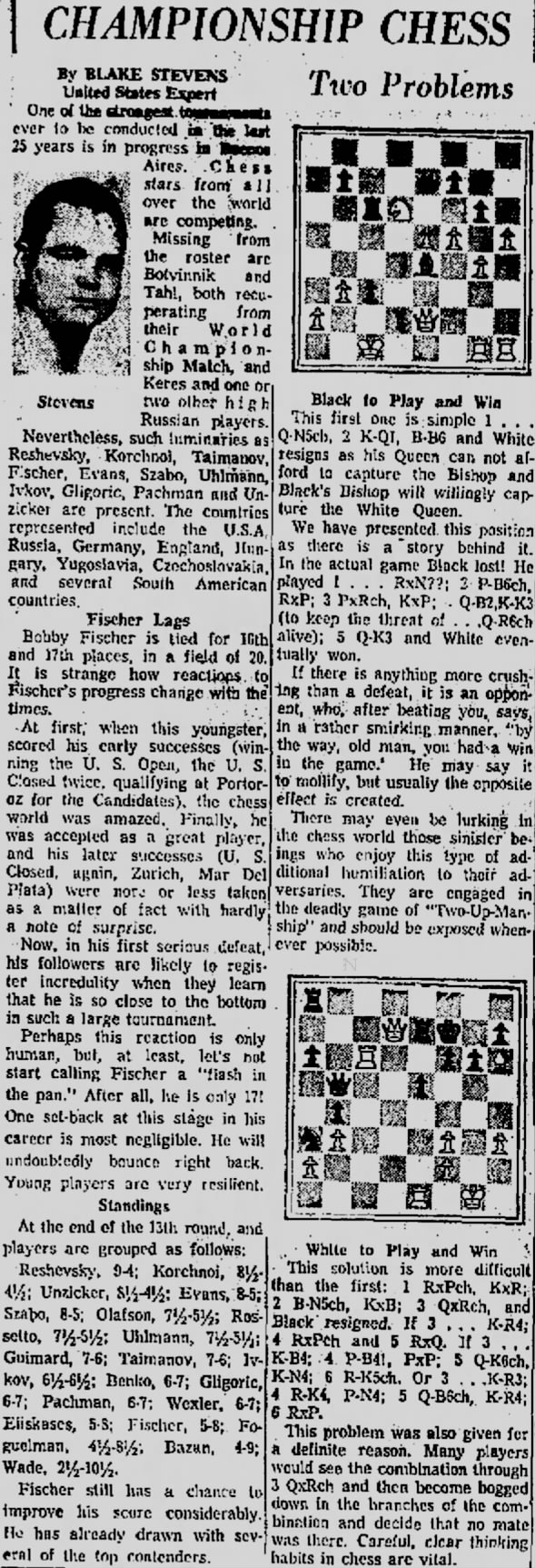 Championship Chess 31 Jul 1960, Sun Express and News (San Antonio, Texas) Newspapers.com
Championship Chess 31 Jul 1960, Sun Express and News (San Antonio, Texas) Newspapers.com
Championship Chess by Blake Stevens
One of the strongest tournaments ever to be conducted in the last 25 years is in progress in Buenos Aires. Chess stars from all over the world are competing.
Missing from the roster are Botvinnik and Tahl, both recuperating from their World Championship Match, and Keres and one or two other high Russian players.
Nevertheless, such luminaries as Reshevsky, Korchnoi, Taimanov, Fischer, Evans, Szabo, Uhlmann, Ivkov, Gligoric, Pachman and Unzicker are present. The countries represented include the U.S.A., Russia, Germany, England, Hungary, Yugoslavia, Czechoslovakia, and several South American countries.
Fischer Lags
Bobby Fischer is tied for 16th and 17th places, in a field of 20. It is strange how reactions to Fischer's progress change with the times.
At first, when this youngster, scored his early successes (winning the U.S. Open, the U.S. Closed twice, qualifying at Portoroz for the Candidates), the chess world was amazed. Finally, he was accepted as a great player, and his later successes (U.S. Closed, again, Zurich, Mar Del Plata) were more or less taken as a matter of fact with hardly a note of surprise.
Now, in his first serious defeat, his followers are likely to register incredulity when they learn that he is so close to the bottom in such a large tournament.
Perhaps this reaction is only human, but, at least, let's not start calling Fischer a “flash in the pan.” After all, he is only 17! One set-back at this stage in his career is most negligible. He will undoubtedly bounce right back. Young players are very resilient.
Standings
At the end of the 13th round, a players are grouped as follows:
Reshevsky, 9-4;
Korchnoi, 8½-4½;
Unzicker, 8½-4½;
Evans, 8-5;
Szabo, 8-5;
Olafsson, 7½-5½;
Rossetto, 7½-5½;
Uhlmann, 7½-5½;
Guimard, 7-6;
Taimanov, 7-6;
Ivkov, 6½-6½;
Benko, 6-7;
Gligoric, 6-7;
Eliskases, 5-8;
Fischer, 5-8;
Foguelman, 4½-8½;
Bazan, 4-9;
Wade, 2½-10½
Fischer still has a chance to improve his score considerably. He has already drawn with several of the top contenders.
< Prev Index Next >
 Chess by Isaac Kashdan 24 Jul 1960, Sun The Los Angeles Times (Los Angeles, California) Newspapers.com
Chess by Isaac Kashdan 24 Jul 1960, Sun The Los Angeles Times (Los Angeles, California) Newspapers.com
Reshevsky Leads In Argentine Tourney
Samuel Reshevsky of Spring Valley, N.Y., former U.S. chess champion, recovered from an early setback to take the lead with a score of 6½-2½ after nine rounds of the international masters' tournament in Buenos Aires, according to a report from the New York Times.
In the first round Reshevsky lost by overstepping the time limit after a difficult battle against Larry Evans of New York, also a former U.S. titleholder. After that Reshevsky won five games and drew with Svetozar Gligoric of Yugoslavia, Victor Korchnoi of Russia and Laszlo Szabo of Hungary.
Korchnoi, who won a critical game from Gligoric, is tied for second at 6-3 with Fridrik Olafsson of Iceland. A half step behind, tied at 5½-3½, are Evans and Wolfgang Unzicker of West Germany.
U.S. champion Bobby Fischer, brilliant 17-year-old Brooklyn schoolboy, lost three of his last four games to slump to 3-5. He has a slight advantage in an adjourned game against Mark Taimanov of Russia. The fourth American in the tournament, Paul Benko of New York, is in a group tied at 4½-4½.
Following is the standing of the players after the ninth round:
—
No games are on hand from the tournament. The following were played in a similar event last April in Mar del Plata, Argentina, in which Fischer tied for first with Boris Spassky of Russia.
 Chess by Isaac Kashdan 10 Jul 1960, Sun The Los Angeles Times (Los Angeles, California) Newspapers.com
Chess by Isaac Kashdan 10 Jul 1960, Sun The Los Angeles Times (Los Angeles, California) Newspapers.com
Reshevsky Leads In Argentine Tourney
Samuel Reshevsky of Spring Valley, N.Y., former U.S. chess champion, recovered from an early setback to take the lead with a score of 6½-2½ after nine rounds of the international masters' tournament in Buenos Aires, according to a report from the New York Times.
In the first round Reshevsky lost by overstepping the time limit after a difficult battle against Larry Evans of New York, also a former U.S. titleholder. After that Reshevsky won five games and drew with Svetozar Gligoric of Yugoslavia, Victor Korchnoi of Russia and Laszlo Szabo of Hungary.
Korchnoi, who won a critical game from Gligoric, is tied for second at 6-3 with Fridrik Olafsson of Iceland. A half step behind, tied at 5½-3½, are Evans and Wolfgang Unzicker of West Germany.
U.S. champion Bobby Fischer, brilliant 17-year-old Brooklyn schoolboy, lost three of his last four games to slump to 3-5. He has a slight advantage in an adjourned game against Mark Taimanov of Russia. The fourth American in the tournament, Paul Benko of New York, is in a group tied at 4½-4½.
Following is the standing of the players after the ninth round:
—
No games are on hand from the tournament. The following were played in a similar event last April in Mar del Plata, Argentina, in which Fischer tied for first with Boris Spassky of Russia.
 Chess Problem No. 584 by H. Hermanson (Sweden) 14 Jul 1960, Thu The Guardian (London, Greater London, England) Newspapers.com
Chess Problem No. 584 by H. Hermanson (Sweden) 14 Jul 1960, Thu The Guardian (London, Greater London, England) Newspapers.com
Viktor Korchnoi vs Dmitry Osipovich Rovner
Leningrad-ch (1957), Leningrad URS
Spanish Game: Closed Variations. Keres Defense (C92) 1-0
< Prev Index Next >
 Chess By Isaac Kashdan 03 Jul 1960, Sun The Los Angeles Times (Los Angeles, California) Newspapers.com
Chess By Isaac Kashdan 03 Jul 1960, Sun The Los Angeles Times (Los Angeles, California) Newspapers.com
Four U.S. Masters In Argentine Tourney
The Argentine Chess Federation, easily the most active chess organization in the Americas, is sponsoring an international masters' tournament in Buenos Aires, with 20 top-ranking stars in attendance.
With partial results after three rounds, the lead was shared by Svetozar Gligoric of Yugoslavia, Ludek Pachman of Czechoslovakia and Laszlo Szabo of Hungary. The three were tied with scores of 2-1, according to a report by the New York Times.
Four grandmasters are representing the United States, headed by 17-year-old champion Bobby Fischer and former champion Larry Evans, who are tied for fourth with 1½-½. Paul Benko got off to a poor start with ½-1½, as did another former U.S. champion, Samuel Reshevsky, who has 0-1.
Two Russian participants have also barely started, Mark Taimanov registering 1-1 and Victor Korchnoi ½-½. Tied at 1½-1½ are Osvaldo Bazan and Bernardo Wexler of Argentina, Boris Ivkov of Yugoslavia and Wolfgang Unzicker of East Germany.
Santa Monica Events
Stephen Sholomson, winning his sixth-round game against Leslie Simon, remained in first place with a 5½-½ score in the masters' invitational tournament at the Santa Monica Bay Chess Club.
Tibor Weinberger kept pace by a victory over J. Mego and retained second position with 5-1. Weinberger missed an opportunity in the previous round when he adjourned with Sholomson in a winning position but allowed the latter to escape by perpetual check after 68 moves.
Emil Bersbach is third with 4-2. Tied at 3½-2½ are Mego, Simon, C. Diesen, Kliger, G. Rubin and E. Warner. Two rounds remain to be played.
Following are the sixth-round results and a game from the tournament:
Stephen Sholomson (white) vs. Leslie Simon (black)
Unresolved Chess Game: Can you solve it?
Descriptive 1. P-K4 P-QB3 2. N-KB3 P-Q4 3. N-B3 B-N5 4. P-KR3 B-R4 5. P-KN4 B-N3 6. PxP PxP 7. B-N5ch N-B3 8. N-K5 Q-Q3 9. P-Q4 P-QR3 10. BxNch PxB 11. B-B4 Q-N5 12. R-QN Q-N2 13. P-KR4 P-B3 14. NxB PxN 15. Q-Q3 K-B2 16. P-R5 PxP 17. PxP P-K3 18. Q-N6ch K-K2 19. K-Q Q-N5 20. Q-Q3 P-K4 21. KR-K P-K5 22. P-R3 K-B2 23. Q-K3 Q-N3 24. P-B3 P-KB4 25. PxP QPxP 26. B-K5 RxP 27. R-KR RxRch 28. RxR N-B3 29. Q-N5 QxNP 30. BxN PxB 31. R-R7ch K-K3 32. Q-N8ch K-Q3 33. Q-B7 Resigns |
Algebraic 1. e4 c6 2. Nf3 d5 3. Nc3 Bg4 4. h3 Bh5 5. g4 Bg6 6. exd5 cxd5 7. Bb5+ Nc6 8. Ne5 Qd6 9. d4 a6 10. Bxc6+ bxc6 11. Bf4 Qb4 12. Rb1 Qb7 13. h4 f6 14. Nxg6 hxg6 15. Qd3 Kf7 16. h5 gxh5 17. gxh5 e6 18. Qg6+ Ke7 19. Kd1 Qb4 20. Qd3 e5 21. Re1 e4 22. a3 Kf7 23. Qe3 Qb6 24. f3 f5 25. fxe4 dxe4 26. Be5 Rxh5 27. Rh1 Rxh1+ |
Boris Spassky vs Yuri N Sakharov
USSR Championship (1960), Leningrad URS, rd 8, Feb-06
King's Gambit: Accepted. Abbazia Defense (C36) 1-0
Mark Taimanov vs Lev Polugaevsky
USSR Championship (1960), Leningrad URS, rd 13, Feb-14
Queen's Gambit Accepted: Mannheim Variation (D23) 1-0
'til the world understands why Robert J. Fischer criticised the U.S./British and Russian military industry imperial alliance and their own Israeli Apartheid. Sarah Wilkinson explains: Tweets by swilkinsonbc |
 “What a sad story Fischer was,” typed a racist, pro-imperialist colonial troll who supports mega-corporation entities over human rights, police state policies & white supremacy. |
To which I replied: “Really? I think he [Bob Fischer] stood up to the broken system of corruption and raised awareness! Whether on the Palestinian/Israel-British-U.S. Imperial Apartheid scam, the Bush wars of ‘7 countries in 5 years,’ illegally, unconstitutionally which constituted mass xenocide or his run in with police brutality in Pasadena, California-- right here in the U.S., police run rampant over the Constitution of the U.S., on oath they swore to uphold, but when Americans don't know the law, and the cops either don't know or worse, “don't care” -- then I think that's pretty darn “sad”. I think Mr. Fischer held out and fought the good fight, steadfast til the day he died, and may he Rest In Peace. Educate yourself about U.S./State Laws -- https://www.youtube.com/@AuditTheAudit/videos After which the troll posted a string of profanities, confirming there was never any genuine sentiment of “compassion” for Mr. Fischer, rather an intent to inflict further defamatory remarks. |
This ongoing work is a tribute to the life and accomplishments of Robert “Bobby” Fischer who passionately loved and studied chess history. May his life continue to inspire many other future generations of chess enthusiasts and kibitzers, alike.
The photograph of Bobby Fischer (above) from the March 02, 1956 The Tampa Times was discovered by Sharon Mooney (Bobby Fischer Newspaper Archive editor) on February 01, 2018 while gathering research materials for this ongoing newspaper archive project. Along with lost games now being translated into Algebraic notation and extractions from over two centuries of newspapers, it is but one of the many lost treasures to be found in the pages of old newspapers since our social media presence was first established November 11, 2017.
